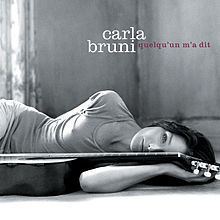Quelqu'un m'a dit ([kɛlkœ̃ madi]; Someone told me) is the debut album of Italian-French singer, model, and former First Lady of France Carla Bruni, released in 2003.
Quelqu'un m'a dit debuted at number one on the French Album Chart, spending thirty-four non-consecutive weeks in the top ten. The album also reached the top ten in Germany, Switzerland, Italy, Portugal and Chile.
Three tracks appeared in Hans Canosa's 2005 American film Conversations with Other Women ("J'en connais", "Le plus beau du quartier", and "L'excessive"), and the song "Le plus beau du quartier" was used in H&M's Christmas 2006 commercial. The title track was played over the closing credits of Mensonges et trahisons et plus si affinités..., included on the (500) Days of Summer soundtrack released in 2009, and appeared in the 2010 Carte d'Or Muffin commercial. The song "Le Ciel Dans Une Chambre" also appeared in an episode of Skins, series 3.
The second track, “Raphaël”, is named for Bruni's then-lover, philosophy professor Raphaël Enthoven, with whom she had a son, Aurélien Enthoven, in 2001.
Bruni has further collaborated with the co-producer, Louis Bertignac, in 2005 duetting with him on the song "Les Frôleuses" on his new album.
1. Quelqu'un m'a dit (Someone Told Me)This melancholy song from which the album draws its name speaks of the sadness of life – "On me dit que nos vies ne valent pas grand chose, / Elles passent en un instant comme fanent les roses." ("They tell me that our lives are not worth very much, / They pass in an instant as roses wilt.") – and that time and fate (destiny) care nothing for us. She forlornly hopes that "you still love me" – "quelqu'un m'a dit / Que tu m'aimais encore," ("Somebody told me / that you loved me still") – recalling that somebody told her, but she cannot remember who.
2. RaphaëlIn this lively and playful song, Bruni sings of her love for her then-lover
Raphaël Enthoven, first reveling in his name – "Quatre consonnes et trois voyelles / c'est le prénom de Raphaël," ("Four consonants and three vowels / that's the first name of Raphaël") – then delighting in his wickedness and their time together. The middle of the song features mysterious lyrics – "Peau de chagrin, pâtre éternel / Archange étrange d’un autre ciel" ("
Shagreen/Sorrow skin, eternal father / Strange archangel from another heaven/sky"), alluding to the magical skin that is slowly used up in Balzac's novel
La Peau de chagrin. She later sings of their love being in the moment – "Pas de promesse à l’éternel" ("No promises of eternity") – compare the title of her next album,
No Promises, and the eventual end of her relationship with Raphaël.
3. Tout le monde (Everyone)This melancholy song tells of how everyone has known disappointment – forgotten childhood memories, remains of dreams ("restes de rêves"), and devastation – and then absurdly suggests that this solitude should be fixed by passing a law – "Il faudrait que tout l'monde réclame auprès des autorités, / Une loi contre toute notre solitude," ("Everyone should demand from the authorities / A law against all our solitude."), musing on French
socialism.
4. La noyée (Drowned)This is a cover of a song by
Serge Gainsbourg, which Bruni heard on the soundtrack to the movie
Romance of a Horsethief (1971); another cover was released near the same time in the 2002 album
C’était ici.The song speaks of time and memory separating people, using contrasting images of water – "la rivière du souvenir" ("the river of memory") and "l'océan de l'oubli" ("the ocean of forgetting").
5. Le toi du moi (You of Me)This love song consists of various pairings of the form "You are my X, I am your Y", "I am the X, you are the Y", or "You are the X of my Y", beginning "Je suis ton pile / Tu es mon face" ("I am your tail / You are my head" [We are two sides of the same coin]), passing through over fifty pairs, climaxing 2/3 of the way through and again ending with "T'es le jamais de mon toujours / T'es mon amour t'es mon amour." ("You are the never of my forever / You are my love you are my love.")Some of the images are playful "T'es la moustache de mon Trotski" ("You are the mustache of my Trotsky"), while some allude to drugs "Toi tu es l’herbe et moi le joint" ("You are the weed and I'm the joint" – marijuana) and "Toi la paille et moi la poudre" ("You the straw and I the powder" –
cocaine); compare
Tu es ma came ("You're My Drug") from her third album,
Comme si de rien n'était.
6. Le ciel dans une chambre (Heaven in a Room)7. J'en connais (I Know Some)8. Le plus beau du quartier (The Most Handsome Boy in Town)9. Chanson triste (Sad Song)10. L'excessive (The Excessive)11. L'amour (Love)12. La dernière minute (The Last Minute)The last song is one minute long, exactly as it says on the tin.

